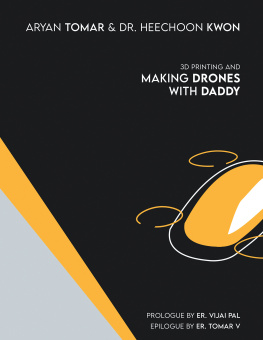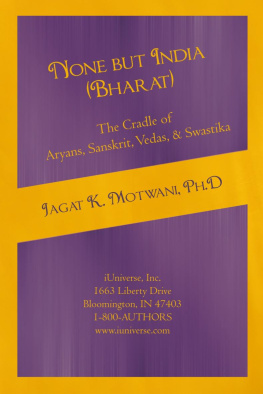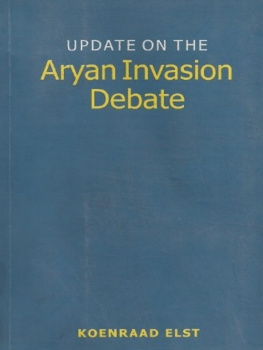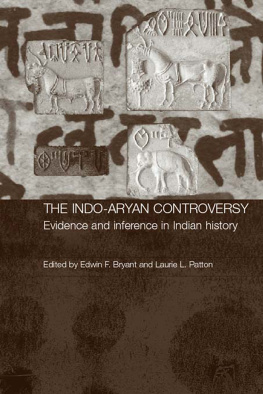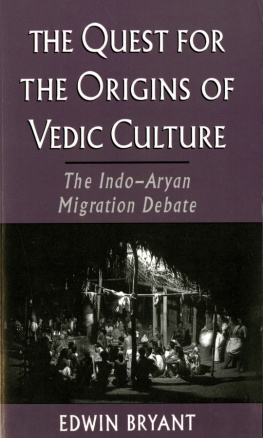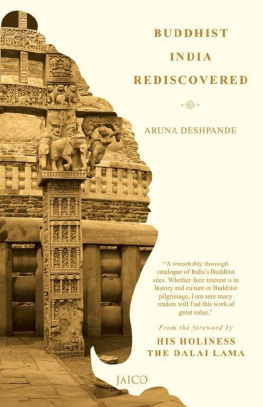Madhav M. Deshpande - Aryan and Non-Aryan in India
Here you can read online Madhav M. Deshpande - Aryan and Non-Aryan in India full text of the book (entire story) in english for free. Download pdf and epub, get meaning, cover and reviews about this ebook. year: 2020, publisher: University of Michigan Center for South and Southeast Asian Studies, genre: Religion. Description of the work, (preface) as well as reviews are available. Best literature library LitArk.com created for fans of good reading and offers a wide selection of genres:
Romance novel
Science fiction
Adventure
Detective
Science
History
Home and family
Prose
Art
Politics
Computer
Non-fiction
Religion
Business
Children
Humor
Choose a favorite category and find really read worthwhile books. Enjoy immersion in the world of imagination, feel the emotions of the characters or learn something new for yourself, make an fascinating discovery.

- Book:Aryan and Non-Aryan in India
- Author:
- Publisher:University of Michigan Center for South and Southeast Asian Studies
- Genre:
- Year:2020
- Rating:5 / 5
- Favourites:Add to favourites
- Your mark:
- 100
- 1
- 2
- 3
- 4
- 5
Aryan and Non-Aryan in India: summary, description and annotation
We offer to read an annotation, description, summary or preface (depends on what the author of the book "Aryan and Non-Aryan in India" wrote himself). If you haven't found the necessary information about the book — write in the comments, we will try to find it.
Aryan and Non-Aryan in India — read online for free the complete book (whole text) full work
Below is the text of the book, divided by pages. System saving the place of the last page read, allows you to conveniently read the book "Aryan and Non-Aryan in India" online for free, without having to search again every time where you left off. Put a bookmark, and you can go to the page where you finished reading at any time.
Font size:
Interval:
Bookmark:

ARYAN AND NON-ARYAN IN INDIA
THE UNIVERSITY OF MICHIGAN
CENTER FOR SOUTH AND SOUTHEAST ASIAN STUDIES
MICHIGAN PAPERS ON SOUTH AND SOUTHEAST ASIA
Number 14
EDITORIAL BOARD
Alton L. Becker
John K. Musgrave
George B. Simmons
Thomas R. Trautmann, chm.
ARYAN AND NON-ARYAN IN INDIA
Edited by
Madhav M. Deshpande and Peter Edwin Hook
Center for South and Southeast Asian Studies
The University of Michigan
Ann Arbor
1979
Open access edition funded by the National Endowment for the Humanities / Andrew W. Mellon Foundation Humanities Open Book Program
Library of Congress Catalog Card Number 78-60016
ISBN 0-89148-014-5
Center for South and Southeast Asian Studies
ISBN 0-89720-012-8
Karoma Publishers, Inc.

Copyright 1979
by
Center for South and Southeast Asian Studies
The University of Michigan
All Rights Reserved
Printed in the United States of America
ISBN 978-0-89148-045-7 (hardcover)
ISBN 978-0-89148-014-3 (paper)
ISBN 978-0-472-12772-6 (ebook)
ISBN 978-0-472-90168-5 (open access)
The text of this book is licensed under a Creative Commons Attribution-NonCommercial-NoDerivatives 4.0 International License: https://creativecommons.org/licenses/by-nc-nd/4.0/
The history and mechanisms of the convergence of ancient Aryan and non-Aryan cultures has been a subject of continuing fascination in many fields of Indology. The papers in this volume are the fruit of a conference on that topic held in December 1976 at The University of Michigan, Ann Arbor, under the auspices of the Center for South and Southeast Asian Studies. The expressed object of the conference was to examine the latest findings from a variety of disciplines as they relate to the formation and integration of a unified Indian culture from many disparate cultural and ethnic elements. Reading them one will notice how often questions posed by one discipline lend themselves to the methodologies or discoveries of another. It is to be hoped that the publication of these essays will help stimulate further progress in the interdisciplinary approach to the study of Indian civilization and to the study of cultural convergence in other parts of the world.
The editors wish to express their gratitude to the contributors, who were prompt in submitting the final versions of their papers and to the Center for South and Southeast Asian Studies of The University of Michigan for having funded both the conference and the publication of these papers.
A. L. BASHAM is well known for his books on the history of ancient India, among them The History and Doctrines of the jvikas, Studies in Indian History and Culture, and above all The Wonder That Was India. He has recently edited A Cultural History of India. The holder of a Ph.D. from the University of London, he was professor of the history of South Asia in the School of Oriental and African Studies of that university for many years. He is now professor and chairman of the Department of Asian Civilizations at the Australian National University.
GEORGE L. HART, III, took a Ph.D. in Sanskrit from Harvard University. His dissertation has been published by the University of California Press under the title, The Poems of Ancient Tamil: Their Milieu and Their Sanskrit Counterparts. A book of translations from Sangam Works will be published in 1979 by Princeton University Press. He is currently an associate professor in the Department of South and Southeast Asian Studies at the University of California, Berkeley.
PETER E. HOOK holds a Ph.D. in linguistics from the University of Pennsylvania. He is currently an associate professor in the Department of Linguistics at The University of Michigan. His book The Compound Verb in Hindi has been published in the Michigan Series in South and Southeast Asian Languages and Linguistics, Center for South and Southeast Asian Studies, The University of Michigan, Ann Arbor. He is presently writing a pedagogical work entitled The Syntactic Structures of Hindi.
COLIN P. MASICA holds a Ph.D. from the University of Chicago where he is currently an associate professor in the Department of South Asian Languages and Civilization. His book Defining a Linguistic Area: South Asia was published by the University of Chicago Press in 1976. He also coauthored, with A. K. Ramanujan, an article entitled Phonological Typology of the Indian Linguistic Area, which appeared in Current Trends in Linguistics, vol. 5.
THOMAS R. TRAUTMANN holds a Ph.D. in history from the University of London. Currently he is Professor of History at The University of Michigan. His first book was Kauilya and the Arthastra: A Statistical Investigation of the Authorship and Evolution, E. J. Brill, Leiden, in 1971. Since that time he has published articles on kinship patterns in India and is currently working on a book entitled The Frontiers of Dravidian Kinship, which is outlined in this volume.
DAVID W. McALPIN holds a Ph.D. from the University of Wisconsin and is currently an assistant professor in the Department of South Asian Regional Studies at the University of Pennsylvania. His research interests include historical and comparative linguistics, generative phonological theory, and Dravidian linguistics. He is currently developing further evidence for the genetic relationship between Elamite and Dravidian on which he has published articles in Language and Current Anthropology.
MADHAV M. DESHPANDE holds a Ph.D. in oriental studies from the University of Pennsylvania. He is currently Associate Professor of Sanskrit in the Department of Linguistics at The University of Michigan. His book Critical Studies in Indian Grammarians I: The Theory of Homogeneity [Svarya] was published in 1975 in the Michigan Series in South and Southeast Asian Languages and Linguistics. His book Semantics in Classical and Medieval India will appear in the same series, and his monograph Sociolinguistic Attitudes in India: An Historical Reconstruction has just been published by Karoma Publishers, Ann Arbor, in the series Linguistica Extranea.
FRANKLIN C. SOUTHWORTH holds a Ph.D. in linguistics from Yale University and is currently Professor of South Asian Linguistics at the University of Pennsylvania. He is known for his book Spoken Marathi which he coauthored with Naresh Kavadi. His The Student's Hindi-Urdu Reference Manual was published by the University of Arizona Press, 1971. He has also coauthored, with Chander J. Daswani, Foundations of Linguistics which was published in 1974 by the Free Press. He has written numerous articles on linguistic archaeology and sociolinguistics and has recently been engaged in developing a new approach to the study of the relationship between ethnic diversity and linguistic variation as they have developed over the past three millennia in South Asia.
CONTENTS
A. L. Basham
George L. Hart, III
Peter Edwin Hook
Colin P. Masica
Thomas R. Trautmann
David W. McAlpin
Franklin C. Southworth
Madhav M. Deshpande
A. L. Basham
Australian National University
The term Aryan is not often heard nowadays except in the ancient Indian context, and after its misuse by Germanic demagogues in the 1930s this is not surprising. It may have philological relationships with words in non-Indian Indo-European languages, but I understand that modern comparative philologists have recently cast some doubt on several of these (e.g., Irish
Font size:
Interval:
Bookmark:
Similar books «Aryan and Non-Aryan in India»
Look at similar books to Aryan and Non-Aryan in India. We have selected literature similar in name and meaning in the hope of providing readers with more options to find new, interesting, not yet read works.
Discussion, reviews of the book Aryan and Non-Aryan in India and just readers' own opinions. Leave your comments, write what you think about the work, its meaning or the main characters. Specify what exactly you liked and what you didn't like, and why you think so.

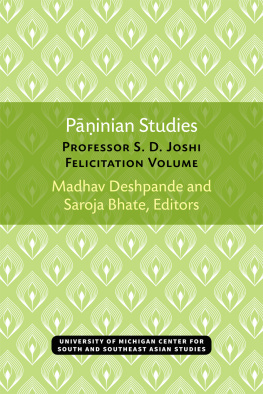
![Madhav Deshpande - Critical Studies in Indian Grammarians I: The Theory of Homogeneity [Sāvarṇya]](/uploads/posts/book/255206/thumbs/madhav-deshpande-critical-studies-in-indian.jpg)
